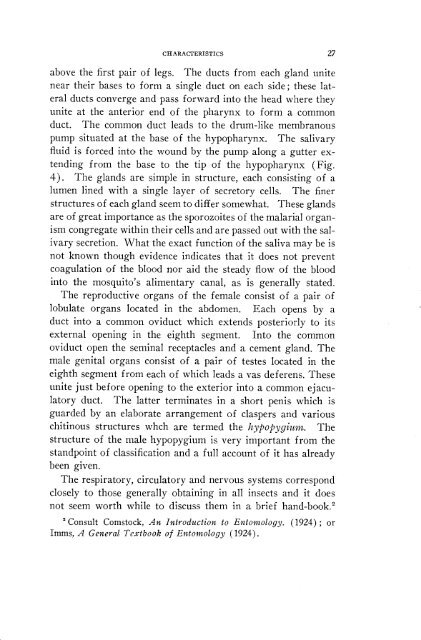a handbook of the mosquitoes of north america - Systematic Catalog ...
a handbook of the mosquitoes of north america - Systematic Catalog ...
a handbook of the mosquitoes of north america - Systematic Catalog ...
You also want an ePaper? Increase the reach of your titles
YUMPU automatically turns print PDFs into web optimized ePapers that Google loves.
CHARACTERISTICS 27<br />
above <strong>the</strong> first pair <strong>of</strong> legs. The ducts from each gland unite<br />
near <strong>the</strong>ir bases to form a single duct on each side; <strong>the</strong>se lat-<br />
eral ducts converge and pass forward into <strong>the</strong> head where <strong>the</strong>y<br />
unite at <strong>the</strong> anterior end <strong>of</strong> <strong>the</strong> pharynx to form a common<br />
duct. The common duct leads to <strong>the</strong> drum-like membranous<br />
pump situated at <strong>the</strong> base <strong>of</strong> <strong>the</strong> hypopharynx. The salivary<br />
fluid is forced into <strong>the</strong> wound by <strong>the</strong> pump along a gutter ex-<br />
tending from <strong>the</strong> base to <strong>the</strong> tip <strong>of</strong> <strong>the</strong> hypopharynx (Fig.<br />
4). The glands are simple in structure, each consisting <strong>of</strong> a<br />
lumen lined with a single layer <strong>of</strong> secretory cells. The finer<br />
structures <strong>of</strong> each gland seem to differ somewhat. These glands<br />
are <strong>of</strong> great importance as <strong>the</strong> sporozoites <strong>of</strong> <strong>the</strong> malarial organ-<br />
ism congregate within <strong>the</strong>ir cells and are passed out with <strong>the</strong> sal-<br />
ivary secretion. What <strong>the</strong> exact function <strong>of</strong> <strong>the</strong> saliva may be is<br />
not known though evidence indicates that it does not prevent<br />
coagulation <strong>of</strong> <strong>the</strong> blood nor aid <strong>the</strong> steady flow <strong>of</strong> <strong>the</strong> blood<br />
into <strong>the</strong> mosquito’s alimentary canal, as is generally stated.<br />
The reproductive organs <strong>of</strong> <strong>the</strong> female consist <strong>of</strong> a pair <strong>of</strong><br />
lobulate organs located in <strong>the</strong> abdomen. Each opens by a<br />
duct into a common oviduct which extends posteriorly to its<br />
external opening in <strong>the</strong> eighth segment. Into <strong>the</strong> common<br />
oviduct open <strong>the</strong> seminal receptacles and a cement gland. The<br />
male genital organs consist <strong>of</strong> a pair <strong>of</strong> testes located in <strong>the</strong><br />
eighth segment from each <strong>of</strong> which leads a vas deferens. These<br />
unite just before opening to <strong>the</strong> exterior into a common ejacu-<br />
latory duct. The latter terminates in a short penis which is<br />
guarded by an elaborate arrangement <strong>of</strong> claspers and various<br />
chitinous structures whch are termed <strong>the</strong> Iz.ypopygium. The<br />
structure <strong>of</strong> <strong>the</strong> male hypopygium is very important from <strong>the</strong><br />
standpoint <strong>of</strong> classification and a full account <strong>of</strong> it has already<br />
been given.<br />
The respiratory, circulatory and nervous systems correspond<br />
closely to those generally obtaining in all insects and it does<br />
not seem worth while to discuss <strong>the</strong>m in a brief hand-book.2<br />
2 Consult Comstock, An Introduction to Entomology. (1924) ; or<br />
Imms, A General Textbook <strong>of</strong> Entomology (1924).

















